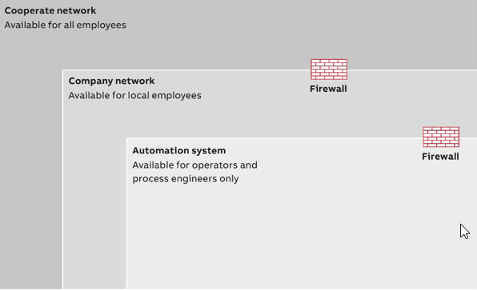The defense in depth approach implements multi-layer IT security measures. Each layer provides its special security measures. All deployed security mechanisms in the system must be updated regularly. It is also important to follow the system vendor’s recommendations on how to configure and use these mechanisms.
As a basis, the components must include security functions such as the following:
-
Virus protection.
-
Firewall protection.
-
Strong and regularly changed passwords.
-
User management, see ⮫ application note.
-
Using VPN tunnels for connections between networks.
Additional security components such as routers and switches with integrated firewalls should be available. A defined user and rights concept managing access to the controllers and their networks is mandatory. Finally, the manufacturer of the components should be able to quickly discover weaknesses and provide patches.
Only used services/ports should be enabled (e.g. to enable the functionality of an FTPS server).
References: ⮫ CODESYS Security Whitepaper
Security zones
IT resources vary in the extent to which they can be trusted. A common security architecture is therefore based on a layered approach that uses zones of trust to provide increasing levels of security according to increasing security needs. Less-trusted zones contain more-trusted zones and connections between the zones are only possible through secure interconnections such as firewalls Fig. 300. All resources in the same zone must have the same minimum level of trust. The inner layers, where communication interaction needs to flow freely between nodes, must have the highest level of trust. This is the approach described in the IEC 62443 series of standards.
Firewalls, gateways, and proxies are used to control network traffic between zones of different security levels, and to filter out any undesirable or dangerous material. Traffic that is allowed to pass between zones should be limited to what is absolutely necessary because each type of service call or information exchange translates into a possible route that an intruder may be able to exploit. Different types of services represent different risks. Internet access, incoming e-mail and instant messaging, for example, represent very high risks.
Fig. 300 shows three safety zones, but the number of zones is not necessarily decisive, there can also be more or less - depending on the safety requirement. The use of multiple zones allows access between zones of different trust levels to be controlled to protect a trusted resource from attack by a less trusted one.
High-security zones should be kept small and independent. They need to be physically protected, i.e. physical access to computers, network equipment and network cables must be limited by physical means to authorized persons only. A high-security zone should obviously not depend on resources in a less secure zone for its security. Therefore, it should form its own domain that is administered from the inside, and not depend on, e.g., a domain controller in a less secure network.
Even if a network zone is regarded as trusted, an attack is still possible: by a user or compromised resource that is inside the trusted zone, or by an outside user or resource that succeeds to penetrate the secure interconnection. Trust therefore depends also upon the types of measures taken to detect and prevent compromise of resources and violation of the security policy.
References: ⮫ Security for industrial automation and control systems

